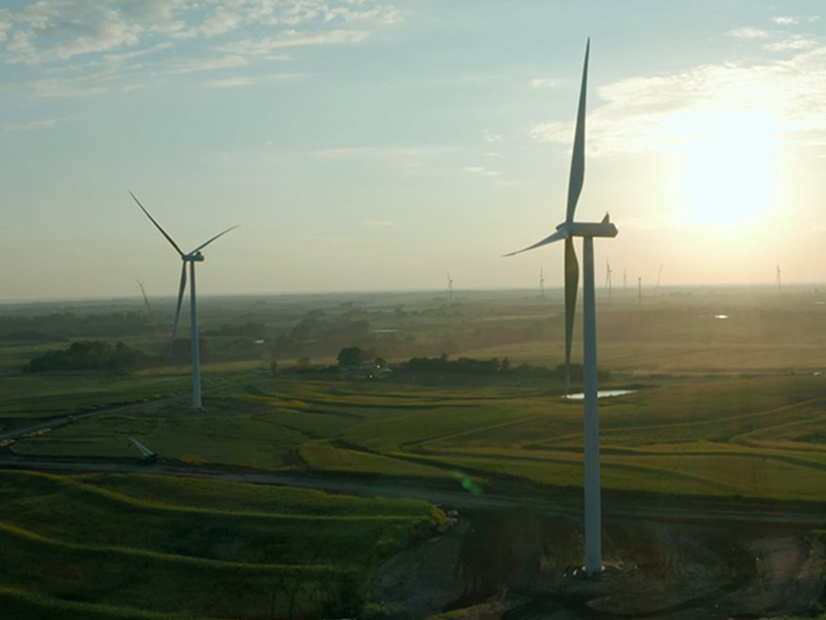A Midwest wind energy developer has filed a complaint with FERC over SPP’s practice of allocating network upgrade costs, alleging that an unexpected $66 million increase slapped onto its wind farm is unjust and reasonable (EL21-77).
Tenaska Clear Creek, an affiliate of Nebraska-based Tenaska, filed the Section 206 complaint May 21. It is asking the commission to halt a multiyear affected system study process that it said “has been characterized by systematic errors, irregularities and delays.” The company said an SPP restudy report assigning the project about $99 million in upgrades — including $66 million to address reliability issues that predate the facility’s interconnection — is “untenable.”

Tenaska’s Clear Creek Project in northern Missouri is the subject of a complaint over SPP transmission planning practices. | Tenaska
Tenaska said it filed the complaint after failing to resolve the matter with SPP and that it hoped the proceeding at FERC would help parties develop a “mutually acceptable solution.”
“Tenaska believes FERC will agree that allocating to Tenaska Clear Creek 100% of the financial consequence of SPP’s actions and the passage of time is unjust and unreasonable and should not be allowed,” Tenaska spokesperson Timberly Ross said in an email.
The 242-MW Clear Creek Project went into commercial operation in May 2020. It is interconnected with the Associated Electric Cooperative, Inc. system in northern Missouri.
According to Tenaska’s complaint, SPP’s initial studies identified about $16 million in network upgrades associated with the Clear Creek project, but the grid operator later more than doubled the cost to $34 million. When a higher-queued project withdrew, SPP’s preliminary restudy assigned $763 million in upgrade costs, a figure that was revised several times down to about $99 million.
Tenaska alleged the withdrawn projected did not affect Clear Creek’s network upgrade cost responsibility. It said the “dramatic” cost increase was a result of SPP’s decision to restart the study process with a new set of models and assumptions. They included adding in 4.5 GW of generation resources that SPP said was omitted from the project’s initial studies, according to the complaint.
Nick Borman, Tenaska’s senior vice president of engineering and construction, said in a statement that the complaint was filed with “reluctance” to raise the broader question of the “appropriate method of allocating interconnection upgrade costs” to FERC’s attention.
“If renewable, or for that matter any, generation projects are to be added to the country’s generation base, certainty around interconnection costs is critical,” Borman said. “We hope FERC will realize that other, more equitable solutions are readily available that will provide the certainty needed for such investments to continue to be made.”
Tenaska warned that inaction by the commission “will certainly impact decision-making by developers of renewable projects on the SPP system and elsewhere.”
An SPP spokesperson said the grid operator is reviewing Tenaska’s complaint and is not yet ready to comment on it.

Rob Gramlich, Grid Strategies | ACORE
“I know FERC is asking a lot of questions about this, and I am hopeful that we will see some proposed reforms soon,” Grid Strategies President Rob Gramlich told RTO Insider.
The American Council on Renewable Energy also spotlighted the difficulties interconnection costs pose to renewable developers in a March report based on interviews with RTO stakeholders and market participants. (See ACORE: Lack of Interregional Tx Planning Slowing Wind, Solar Development.)
The report says current planning processes are not designed to identify the best methods for getting renewable energy to load. It emphasized the need for a “centrally coordinated and integrated” planning process.
“There is a basic structural problem across most ISO/RTOs because of the reactive project-by-project or cluster-by-cluster approach,” Gramlich said. “RTO planners need to turn on the headlights and plan for future needs, like planners of any public utility do.”
Like other grid operators, SPP has added staff as it struggles to work through an interconnection queue with projects dating back to 2017. As of April, the backlog included 451 interconnection requests totaling 79.9 GW of capacity.
Stakeholders have complained about restudies following a project’s withdrawal, which often happens when projects are assigned high network upgrade costs. Stakeholders and staff are working together on long-term planning recommendations to re-engineer the transmission planning processes. (See “GI Backlog a Pressing Issue,” SPP MOPC Briefs: April 12-13, 2021.)
“Interconnection costs are wildly variable and hard to predict, so it is no wonder developers put in multiple requests. At the same time, the RTO planners are pulling their hair out over multiple requests and projects dropping out of the queue all the time.” Gramlich said, calling the situation an indication of a “dysfunctional and inefficient process.”

